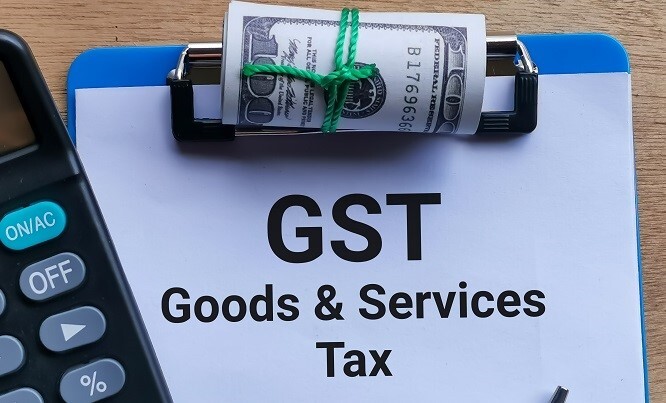
 Data Structure
Data Structure Networking
Networking RDBMS
RDBMS Operating System
Operating System Java
Java MS Excel
MS Excel iOS
iOS HTML
HTML CSS
CSS Android
Android Python
Python C Programming
C Programming C++
C++ C#
C# MongoDB
MongoDB MySQL
MySQL Javascript
Javascript PHP
PHP
- Selected Reading
- UPSC IAS Exams Notes
- Developer's Best Practices
- Questions and Answers
- Effective Resume Writing
- HR Interview Questions
- Computer Glossary
- Who is Who
What is the full form of GST?
Introduction
Goods and Services Tax (GST) is imposed by the government at each point when goods and services are sold. For example, GST collection takes place in Bengaluru and not Bhubaneswar if a company in Bhubaneswar manufactures a good with Bengaluru as its main market. Because manufacturers must pay tax at each stage of manufacturing, it is a multiple phases tax.

Every point-of-sale transaction is subject to taxation, including purchases of raw materials, manufacturing expenses, charges associated with storing raw materials and completed goods, purchases made at wholesale, and sales to ultimate customers.
Adding value to commodities occurs at every level of the manufacturing process. Every time a business adds value to a product, it must pay GST. For instance, wool is processed through several processes before being used to make garments. When wool is turned into fiber and then into the fabric, the business must pay GST. When they buy the fabric in a retail setting to make a garment, consumers must pay GST.
Advantages of GST
Stakeholders such as state and federal governments, corporations, and citizens, can gain from the GST. GST can lower prices for goods and services, stimulate the economy, and improve service providers' and manufacturers' competitiveness. These are its main advantages. A taxpayer may use an input credit under GST for value addition. The automated procedure enables the flawless transmission of contribution credits across the transaction's value chain. It might increase tax compliance. GST has the ability to integrate the marketplace through a consistent tax system by removing a variety of barriers. GST offers other advantages, such as
It creates a single tax code out of many indirect taxes levied by the federal and state governments
It lessens flow and raises the competitiveness of Indian businesses and goods.
It permits the use of tax credits in multiple ways.
Exporters are granted an 80 % - 90% temporary reimbursement. They can streamline their operations as a result.
It will probably broaden the base of taxpayers.
The possibility of cheating is reduced by uniform GST rates.
To enable better compliance, it creates a standard set of laws, practices, and tax rates.
GST implementation in India
One of the largest changes to indirect taxation is the Goods and Services Tax (GST) in India. It is based on the idea of destination-based consumption taxation and became applicable across all of India on July 1st, 2017. In order to establish a uniform tax system throughout the nation, the Indian government established the Goods and Service Tax Council or GSTC. The Union Finance Minister, the Minister of State, and the State Finance Ministers make up the GSTC. This council makes decisions regarding the GST rate, exemptions, thresholds, subsuming taxes, and other issues.
GST impact on various sectors of the economy
All of the major brands in the nation were significantly impacted by GST services since businesses saw enormous development. The following are some advantages that the different business sectors have reaped since the introduction of the GST
Agricultural industry The biggest contribution of any industry to the Indian economy is made by the agriculture sector, which accounts for 16% of GDP. The introduction of the GST was good news for the major companies in this industry because it relieved them of the burden of paying the high transportation expenses across all states as they had in the past. As a result, they have been able to conserve a sizeable portion of their financial resources and invest it in locations with higher rates of productivity, which has improved agriculture.

Automobile industry After the introduction of the GST, all existing taxes, including the road tax, tax on sales, VAT, and excise duties, were replaced by the GST, which significantly increased the sales of cars. In 2018 and 2019, record growth was achieved by many major vehicle brands. Customers believed that it was the best moment to buy cars, particularly with credit cards where they were able to save a lot of money.
The Indian economy's foundation is generally regarded as being in the logistics sector. The introduction of GST gave the major players in this industry a much-needed boost, enabling them to extend operations across the nation, enabling them to achieve their goals, and succeed in attracting customers and investors
Conclusion
GST may have advantages and disadvantages, but it is a permanent fixture in India. There may be restrictions on whether you must pay GST depending on the state in which your business is located, but most firms are required to do so. Given that GST combines a number of former tax components, it will ultimately be much simpler for accounting and tax consultants. It is better to let a qualified GST consultant handle the task because GST must be filed on a consistent basis.
FAQs
Q1. What impact does GST have on India's real estate market?
Ans: Currently, the real estate sector continues to be one of the most significant drivers of the overall Indian economy, accounting for 8% of GDP. Before the GST was implemented in India, there were a variety of connected costs that would need to be paid if you wanted to purchase a property that was still being built, including VAT, registration fees, taxes on services, and registration and stamp duty fees.
Q2. What modifications have been made to the GST rate structure for 2017?
Ans: Despite the fact that the whole rate structure remains unchanged, there has been a considerable improvement in the reduction of GST rates for different products. Only 3 percent of items are currently subject to the 28 percent GST rate, down from 19 percent on July 1, 2017.
Q3. What are the problems with GST implementation in India?
Ans: They include the difficult requirements for companies to gather and disclose transaction-wise data onto the computerized portal for all companies with annual revenue over 7.5 million rupees. In order to determine the relevant tax rate, goods, and services must be identified with an HSN code, which causes problems.

